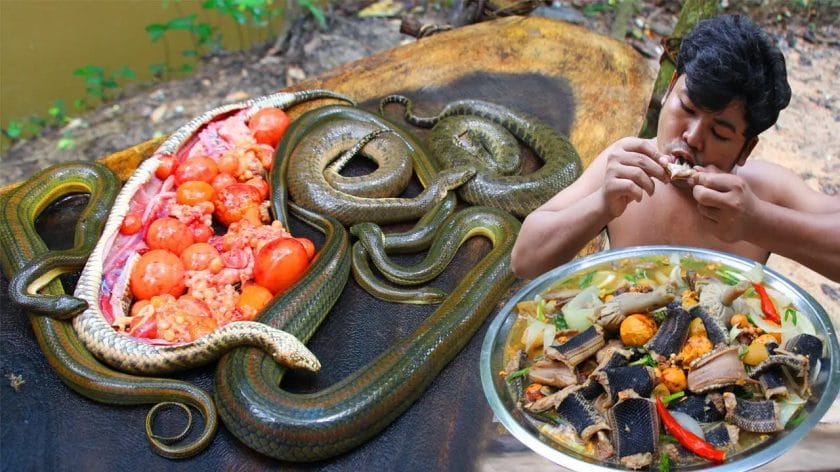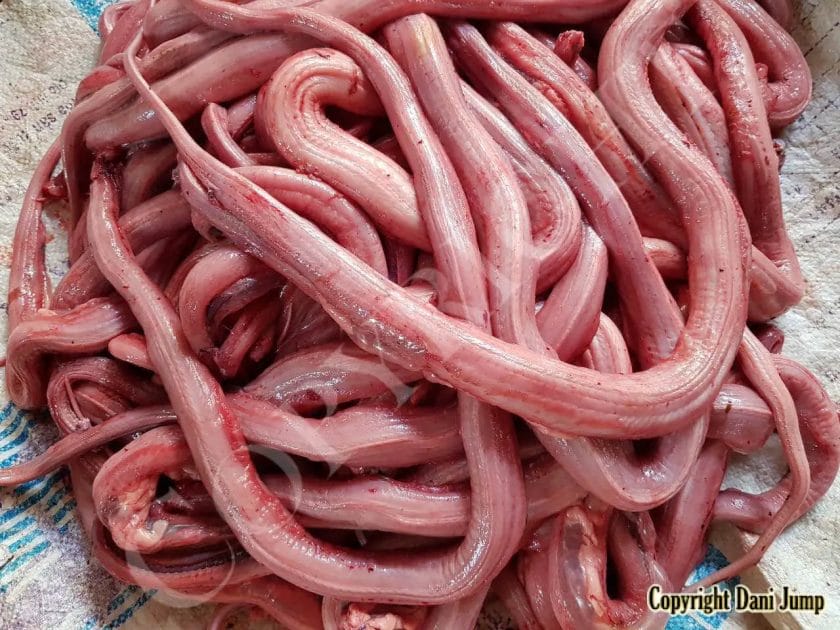Snake meat is considered a delicacy in many parts of the world, known for its unique flavor and texture.
When cooked properly, snake meat can be tender, lean, and slightly gamey, resembling a cross between chicken and fish.
It is often described as having a mild, delicate flavor that can vary depending on the species of snake and the cooking method.
Commonly consumed in certain Asian and African countries, snake meat is said to offer various health benefits and is believed to have medicinal properties.
However, it’s important to note that consuming snake meat should be done with caution, as some species may be toxic or carry diseases.

Exploring Different Snake Meat Preparations
In this section, we will delve into the various ways snake meat can be prepared and enjoyed as a culinary delicacy. Snake meat has been consumed in many cultures for centuries, prized for its unique flavor and nutritional value. From traditional dishes to modern interpretations, there are several enticing preparations to discover.
1. Snake Soup
Snake soup is a popular dish in Chinese cuisine, especially in Hong Kong. It is often considered a winter delicacy due to its warming properties. The soup is typically made with a combination of snake meat, along with chicken or pork, herbs, and spices. It is simmered for hours to extract the essence and create a rich, flavorful broth. Snake soup is known for its health benefits and is believed to boost vitality and strengthen the body.
2. Grilled Snake
Grilling snake meat is a simple yet delicious way to enjoy its natural flavors. The meat can be marinated in a combination of herbs, spices, and oils to enhance its taste. It is then cooked over an open flame or on a barbecue grill until tender and succulent. The result is a smoky and slightly gamey meat, perfect for adventurous eaters who appreciate bold flavors.
3. Snake Stir-Fry
Snake meat can also be incorporated into stir-fry dishes, adding a unique twist to traditional Asian recipes. The meat is thinly sliced and quickly cooked over high heat with an array of vegetables, sauces, and aromatic spices. The stir-frying process retains the meat’s tenderness while infusing it with vibrant flavors. The combination of textures and the medley of ingredients make snake stir-fries a delightful and visually appealing option.
4. Snake Curry
Curries are a staple in many cuisines, and snake meat can be an interesting addition to curry dishes. The meat is slow-cooked in a fragrant blend of spices, coconut milk, and other complementary ingredients. The rich and creamy curry sauce helps to tenderize the meat while imparting a delightful medley of flavors. Snake curry is a hearty and satisfying meal that showcases the versatility of snake meat.
5. Snake Sausages
An innovative way to enjoy snake meat is by creating flavorful sausages. The meat is ground and mixed with various spices, herbs, and other ingredients to create a unique blend. The mixture is then stuffed into sausage casings and cooked through either grilling, frying, or steaming. Snake sausages offer a convenient and delectable way to savor the distinct taste of snake meat.
6. Snake Jerky
Snake jerky is a popular snack in some cultures, offering a convenient and long-lasting way to enjoy snake meat. The meat is sliced into thin strips and marinated in a blend of seasonings and spices. It is then dried or smoked to remove moisture and create a chewy texture. Snake jerky is a high-protein, low-fat snack that can be enjoyed on-the-go or added to trail mixes for a unique twist.
7. Snake Spring Rolls
Snake spring rolls are a creative fusion of traditional Asian cuisine and the exotic flavors of snake meat. The meat is finely minced and combined with a mixture of vegetables, herbs, and spices. It is then wrapped in spring roll wrappers and deep-fried until crispy and golden. Snake spring rolls offer a delightful combination of textures and flavors, making them an intriguing appetizer or snack option.
8. Snake Skewers
Snake skewers are a popular street food in some cultures, providing a flavorful and portable culinary experience. The meat is cut into bite-sized pieces and skewered along with vegetables and seasonings. It is then grilled over an open flame, imparting a smoky char and enhancing the taste of the meat. Snake skewers are a savory and convenient way to enjoy the unique flavors of snake meat.
In summary, snake meat can be prepared in various ways, each offering a different culinary experience. From traditional soups and curries to modern interpretations like sausages and spring rolls, there are numerous options to explore. Whether you are an adventurous eater or someone curious about exotic flavors, snake meat preparations provide a tantalizing journey for the taste buds.

Snake as a Delicacy: Taste and Texture Explained
Snake meat may not be a common choice for many people when it comes to culinary experiences, but in certain regions and cultures, it is considered a delicacy. The unique taste and texture of snake meat can be an intriguing and adventurous gastronomic experience. In this section, we will delve into the details of the taste and texture of snake meat and why it is sought after by some.
Taste of Snake Meat
The taste of snake meat can vary depending on the species of snake and the way it is prepared. Generally, snake meat is described as having a mild, delicate flavor that is often compared to chicken or fish. However, it also possesses a distinct taste that sets it apart from more common meats.
When cooked properly, snake meat can be tender and succulent, with a slightly gamey undertone. The flavor can be influenced by various factors such as the snake’s diet, habitat, and age. Some species of snakes may have a stronger and more pronounced taste, while others may be milder.
One of the reasons snake meat is considered a delicacy is the unique blend of flavors it offers. It can be subtly sweet, with hints of earthiness and a slightly wild or reptilian essence. The taste can be further enhanced by marinating or seasoning the meat with herbs, spices, or sauces.
Texture of Snake Meat
The texture of snake meat is another intriguing aspect that makes it a sought-after delicacy. It is generally lean and firm, with a unique combination of tenderness and firmness. The texture can vary slightly depending on the species and the cut of meat.
When cooked properly, snake meat can be surprisingly tender, similar to poultry meat. It has a delicate fibrous structure that gives it an interesting mouthfeel. The meat is often described as flaky or slightly chewy, providing a satisfying texture that adds to the overall dining experience.
Snake meat can be prepared in various ways to showcase its texture. It can be grilled, stir-fried, or even used in soups and stews. The firmness and texture of the meat make it versatile and adaptable to different cooking methods.
Health Benefits of Snake Meat
In addition to its unique taste and texture, snake meat is also known for its potential health benefits. It is a lean source of protein and contains essential amino acids necessary for muscle growth and repair.
Snake meat is also relatively low in fat, making it a good option for those looking to reduce their fat intake. It is rich in omega-3 fatty acids, which are beneficial for heart health and inflammation reduction. The meat is also a good source of vitamins and minerals, including vitamin B, zinc, and selenium.
However, it is important to note that consuming snake meat should be done with caution, as it can carry certain risks. Snakes may harbor parasites or toxins, so it is crucial to source the meat from reputable suppliers and ensure it is properly cooked to eliminate any potential health hazards.
In summary, snake meat offers a unique tasting experience with its mild yet distinct flavor. Its texture, tender yet firm, adds to the overall appeal of this delicacy. While being a source of lean protein and essential nutrients, it is essential to exercise caution and consume snake meat from trusted sources to ensure safety and minimize health risks.

Exotic Snake Cuisine: Unusual Flavors and Pairings
Snake cuisine has gained popularity in recent years as adventurous food enthusiasts seek out unique and unconventional dining experiences. This article explores the world of exotic snake cuisine, highlighting the unusual flavors and pairings that make it a fascinating culinary adventure.
The Appeal of Snake Cuisine
Snake meat has been consumed in various cultures for centuries, valued for its nutritional benefits and perceived medicinal properties. In addition to its historical significance, snake cuisine offers a thrill of the exotic, satisfying the curiosity of those seeking new and daring gastronomic experiences. As a result, restaurants and food festivals around the world have started to incorporate snake dishes into their menus, attracting food enthusiasts from all walks of life.
Unusual Flavors
Snake meat possesses a distinct flavor that sets it apart from more conventional meats. It is often described as delicate, subtle, and slightly fish-like. The taste can vary depending on the species of snake and the cooking method used. Some common flavors associated with snake meat include a hint of sweetness, earthiness, and a unique umami undertone.
One popular snake dish is snake soup, a delicacy commonly found in Chinese cuisine. The soup is made by slow-cooking snake meat with a variety of herbs and spices, resulting in a rich and flavorsome broth. The combination of tender snake meat and aromatic ingredients creates a unique flavor profile that is both comforting and intriguing.
Another noteworthy snake-based dish is snake stir-fry. This preparation method involves quickly cooking thin slices of snake meat with an assortment of vegetables and sauces, resulting in a dish that is both flavorful and visually appealing. The crisp texture of the vegetables perfectly complements the tender snake meat, creating a delightful contrast of textures.
Unconventional Pairings
Snake cuisine offers a myriad of unconventional pairings that elevate the dining experience to new heights. One such pairing is snake meat with fruit, particularly tropical fruits like mango and pineapple. The juicy sweetness of these fruits provides a refreshing contrast to the savory flavors of the snake meat, creating a harmonious balance of taste.
Additionally, snake meat can be paired with aromatic herbs and spices to create an intriguing fusion of flavors. Ingredients such as lemongrass, ginger, and garlic add depth and complexity to snake dishes, enhancing the overall taste profile. These bold flavor combinations surprise the palate and leave a lasting impression on adventurous food lovers.
Snake Cuisine Around the World
Snake cuisine is not limited to a specific region or culture. It can be found in various countries across the globe, each offering its own unique take on these exotic dishes.
In China, snake dishes are deeply rooted in traditional medicine practices and are often associated with vitality and rejuvenation. Snake wine, a popular Chinese delicacy, involves steeping whole snakes in rice wine for several months, resulting in a potent beverage that is believed to have health benefits.
In Vietnam, snake meat is typically served in the form of snake spring rolls or grilled snake skewers. The combination of fresh herbs, vermicelli noodles, and snake meat wrapped in rice paper creates a delightful burst of flavors and textures.
Thailand is known for its diverse snake cuisine offerings, including snake blood shots and fried snake bones. These unconventional dishes showcase the creativity and ingenuity of Thai chefs, who are always pushing the boundaries of culinary exploration.
In Summary
Exotic snake cuisine provides a unique and unforgettable dining experience for those willing to step outside their culinary comfort zones. With its unusual flavors and unconventional pairings, snake dishes offer a fusion of taste and adventure that is sure to captivate even the most discerning food enthusiasts. Whether you’re indulging in a steaming bowl of snake soup or savoring the delicate flavors of a snake stir-fry, snake cuisine promises an unforgettable culinary journey.
Cooking Tips and Recipes for Snake Meat
If you are an adventurous food lover and want to try something unique and exotic, snake meat might pique your interest. Snake meat is a delicacy in some cultures and offers a distinct flavor and texture. However, cooking snake meat requires some special techniques to ensure it is cooked properly. In this section, we will explore some cooking tips and recipes to help you make the most of your snake meat.
1. Choosing the Right Snake
Before you start cooking snake meat, it is crucial to select the right snake. Make sure to buy snake meat from a reputable source to ensure it is safe to consume. You can choose from various snake species such as python, cobra, or rattlesnake. It is recommended to opt for farm-raised snakes as they are generally safer to eat than wild-caught ones.
2. Preparing Snake Meat
Once you have obtained snake meat, it is essential to prepare it correctly before cooking. Follow these steps:
- Remove the skin: Use a sharp knife to carefully remove the skin from the snake. Start from the head and peel it off gently.
- Remove the organs: Cut open the belly and carefully remove the internal organs. Rinse the meat under cold water to clean it thoroughly.
- Trim the fat: Snake meat can be fatty, so trim off any excess fat to ensure a leaner and healthier dish.
- Marinate (optional): If desired, you can marinate the snake meat in your favorite seasonings or spices for a few hours to enhance the flavor.
3. Cooking Methods
Snake meat can be cooked using various methods, depending on your preference. Here are a few popular cooking techniques:
a. Grilling
Grilling snake meat imparts a smoky flavor and creates a delicious charred exterior. Cut the snake meat into manageable pieces and season it with salt, pepper, and your choice of herbs and spices. Preheat the grill to medium-high heat and cook the meat for about 4-6 minutes per side, or until it reaches an internal temperature of 145°F (63°C).
b. Stir-Frying
Stir-frying snake meat is a quick and easy way to prepare it. Slice the snake meat into thin strips and marinate it with soy sauce, garlic, and ginger. Heat oil in a wok or skillet over high heat. Add the marinated snake meat and stir-fry for 3-4 minutes, or until cooked through.
c. Braising
Braising snake meat results in a tender and flavorful dish. Cut the snake meat into chunks and season it with salt, pepper, and your choice of spices. Heat oil in a large pot or Dutch oven and brown the meat on all sides. Add broth or wine, along with vegetables and herbs of your choice. Cover the pot and simmer for 1-2 hours, or until the meat is tender.
4. Recipes
a. Snake Meat Skewers
Ingredients:
- 1 pound snake meat, cut into cubes
- 2 tablespoons soy sauce
- 1 tablespoon honey
- 1 teaspoon garlic powder
- 1 teaspoon paprika
- Wooden skewers, soaked in water
Instructions:
- In a bowl, mix together soy sauce, honey, garlic powder, and paprika.
- Add the snake meat cubes to the bowl and marinate for 30 minutes.
- Preheat the grill to medium-high heat.
- Thread the marinated snake meat onto the soaked wooden skewers.
- Grill the skewers for 4-6 minutes per side, or until the meat is cooked through.
- Serve hot and enjoy!
b. Snake Meat Stir-Fry
Ingredients:
- 1 pound snake meat, thinly sliced
- 2 tablespoons soy sauce
- 1 tablespoon oyster sauce
- 1 teaspoon garlic, minced
- 1 teaspoon ginger, grated
How does snake taste?
The taste of snake meat can vary depending on the species, but it is often described as having a mild, chicken-like flavor with a hint of fishiness. The texture can also vary, with some species having a firm and slightly chewy texture.
Conclusion:
In conclusion, the taste of snake meat is a unique experience that varies depending on the cooking method and seasoning. Some describe it as a cross between chicken and fish, with a tender and slightly gamey texture. Snake meat is known for its nutritional benefits as it is low in fat and high in protein. Whether it’s grilled, fried, or incorporated into stir-fries and soups, snake meat offers a new and adventurous culinary experience for those willing to try it.
The exotic nature of snake meat also makes it a popular choice among adventurous eaters and those seeking new flavors. It is important to note that consuming snake meat should be done responsibly and in accordance with local regulations to ensure sustainability and animal welfare. In summary, while the taste of snake meat may not be for everyone, it presents an intriguing option for those looking to expand their culinary horizons and try something different.
